
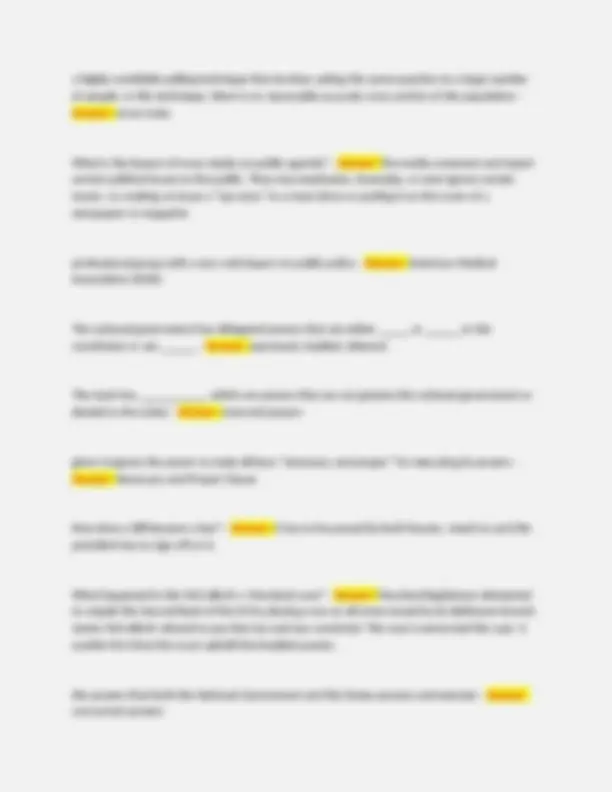
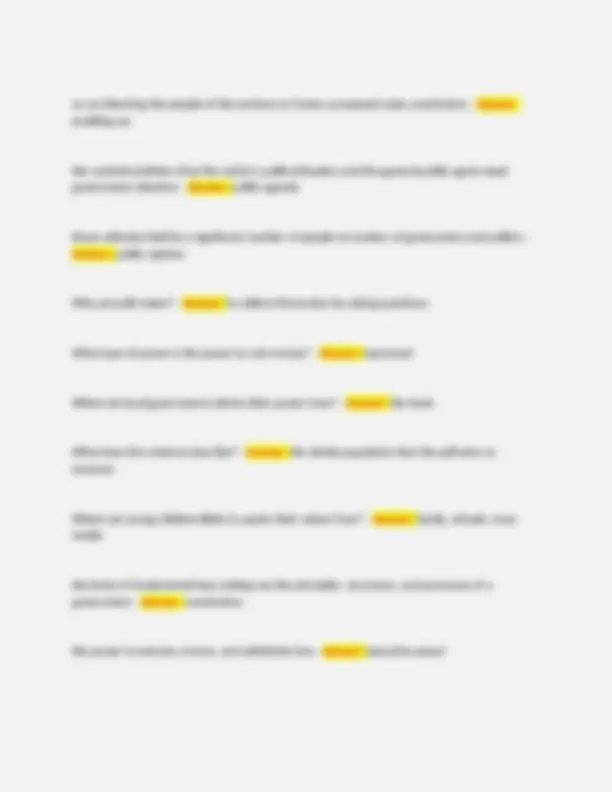
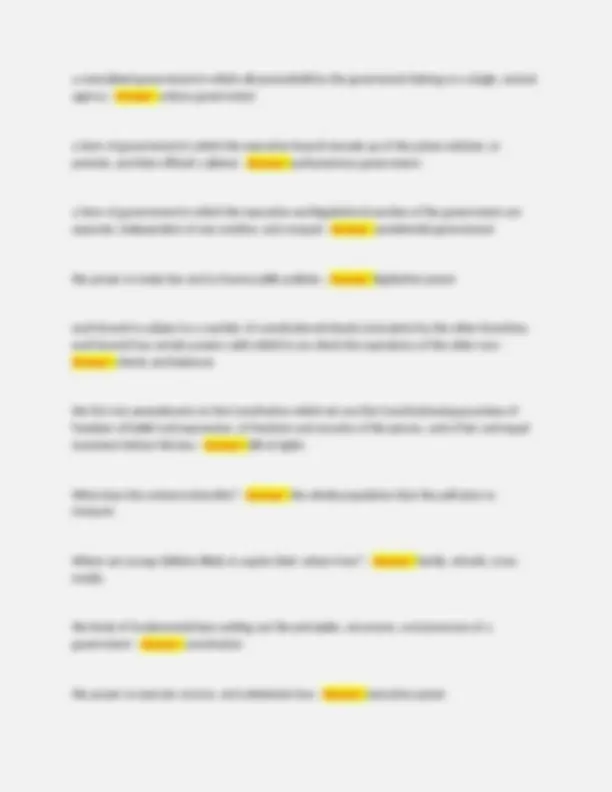
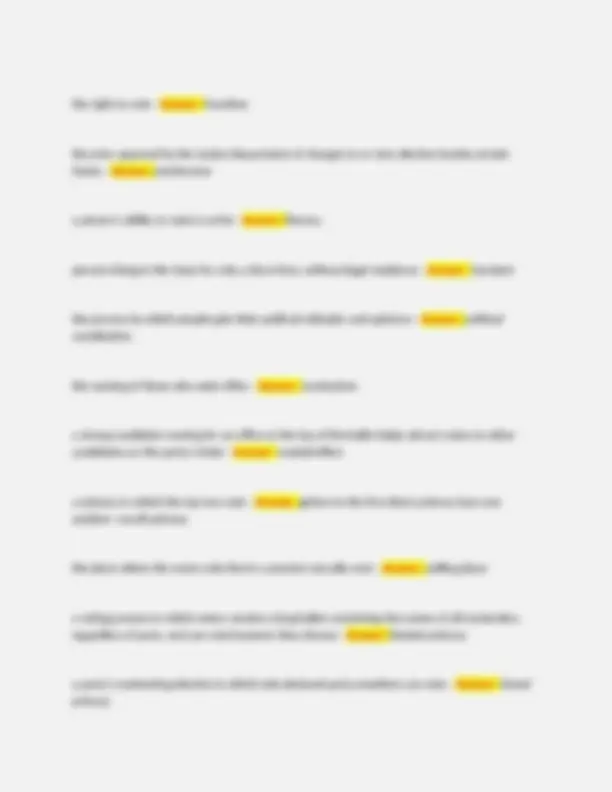
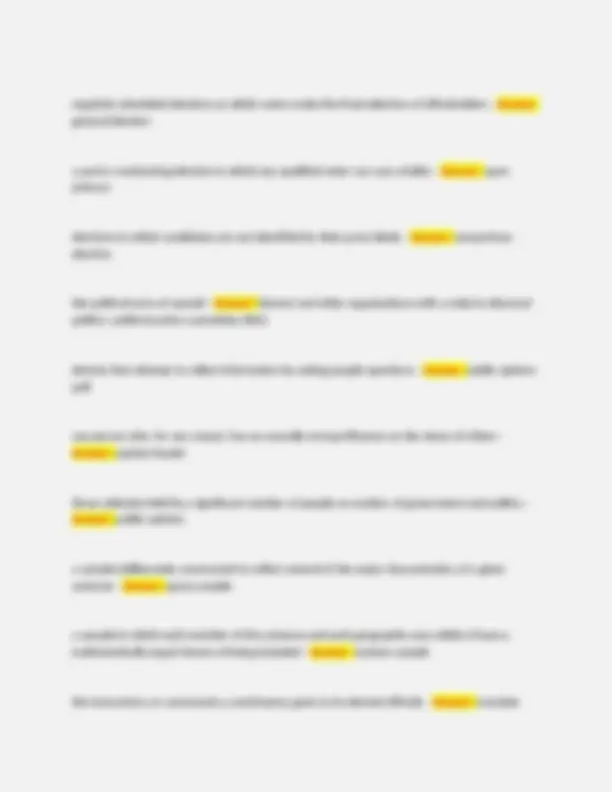



Study with the several resources on Docsity

Earn points by helping other students or get them with a premium plan


Prepare for your exams
Study with the several resources on Docsity

Earn points to download
Earn points by helping other students or get them with a premium plan
Community
Ask the community for help and clear up your study doubts
Discover the best universities in your country according to Docsity users
Free resources
Download our free guides on studying techniques, anxiety management strategies, and thesis advice from Docsity tutors
A comprehensive review of key concepts related to the u.s. Government, designed as a study guide for final exams. It covers essential topics such as the legislative, executive, and judicial powers, the features of state constitutions, presidential powers, and the roles of different government bodies. The guide also addresses voter registration, the impact of mass media, and the process of how a bill becomes a law, offering a structured approach to understanding the fundamental principles and functions of the u.s. Government. It is useful for students preparing for exams or anyone seeking a concise overview of american political systems. (410 characters)
Typology: Exams
1 / 10

This page cannot be seen from the preview
Don't miss anything!







The power to make law and to frame public policies - Answer: legislative power the power to execute, enforce, and administer law - Answer: executive power the power to interpret laws, to determine their meaning, and to settle disputes that arise within the society - Answer: judical power What are the common features of the first state constitutions? - Answer: popular sovereignty (govt. can only exist with the consent of the governed), limited government, civil rights and liberties, and seperation of powers and checks and balances What is the extent of presidential powers? - Answer: power to act as commander in chief of the armed forces, power to grant reprieves and pardons, power to make treaties, and power to appoint major federal officials The legislative, executive, and judicial powers of government are distributed - Answer: separated-among three distinct and independent branches of the government- seperation of powers What worries did the smaller states have when the constitution was being formed? - Answer: feared that they would not be able to protect their interests What is the role of precinct election boards? - Answer: supervises the polling place and the voting process in each precinct; draws precinct lines, fixes the location of each polling place, and picks the members of the precinct boards; opens and closes the polls at the times set by State
law, see that the ballots and the ballot boxes are available, and counts the votes cast in each precinct What are the different ways to run for President? - Answer: self-announcement, caucus, convention, direct primary, and petition What are the reasons for voter registration? - Answer: gives election officials a list of those persons who are qualified to vote and identifies voters in terms of their party preference What is the role of minor party candidates? - Answer: "spoiler role"-pull votes from one of the major parties critic and innovator - Answer: draw attention to some issue that the major parties have ignored the power of a court to determine the constitutionality of a government action - Answer: judicial review Declares that no state can draw unreasonable distinctions between its own residents and those who live in other staes. However, residents of a state may have certain privliges because they are the taxpayers i.e. - Answer: instate tution, lower hunting fees, and holding public office- Privileges and Immunities Clause States credit shall be given by all states to the public acts, records, and judicial proceedings that took place in another state - Answer: Full Faith in Credit Clause the legal process by which a fugitive from justice in one state is returned to that state - Answer: extradition
an act directing the people of the territory to frame a proposed state constitution - Answer: enabling act the societal problems that the nation's political leaders and the general public agree need government attention - Answer: public agenda those attitudes held by a significant number of people on matters of government and politics - Answer: public opinion Why are polls taken? - Answer: to collect information by asking questions What type of power is the power to coin money? - Answer: expressed Where do local governments derive their power from? - Answer: the State What does the universe describe? - Answer: the whole population that the poll aims to measure Where are young children likely to aquire their values from? - Answer: family, schools, mass media the body of fundamental laws setting out the principles, structures, and processes of a government - Answer: constitution the power to execute, enorce, and administer law - Answer: executive power
a centralized government in which all powersheld by the government belong to a single, central agency - Answer: unitary government a form of government in which the executive branch ismade up of the prime minister, or premier, and that official's cabinet - Answer: parliamentary government a form of government in which the executive and legislative branches of the government are separate, independent of one another, and coequal - Answer: presidential government the power to make law and to frame public policies - Answer: legislative power each branch is subject to a number of constitutional checks (restraints) by the other branches; each branch has certain powers with which it can check the operations of the other two - Answer: checks and balances the first ten amendments to the Constitution which set out the Constitutional guarantees of freedom of belief and expression, of freedom and security of the person, and of fair and equal treatment before the law - Answer: bill of rights What does the universe describe? - Answer: the whole population that the poll aims to measure Where are young children likely to aquire their values from? - Answer: family, schools, mass media the body of fundamental laws setting out the principles, structures, and processes of a government - Answer: constitution the power to execute, enorce, and administer law - Answer: executive power
to declare illegal, null and void, of no force and effect - Answer: unconstitutional a unit into which cities are often divided for the election of city council members - Answer: ward the people eligible to vote - Answer: electorate one of the many political parties without wide voter support in this country - Answer: minor party the largest number of votes cast for the office - Answer: plurality a group of persons who seek to control government through the winning of elections and the holding of public office - Answer: political party voting for candidates of different parties for different offices at the same election - Answer: split-ticket voting minor parties that have splint away from one of the major parties - Answer: splinter parties in American politices, the Republican and the Democratic parties - Answer: major party the two major parties find common ground and work together here - Answer: bipartisan the loyalty of people to a particular political party - Answer: party identification the practice of voting for candidates of only one party in an election - Answer: straight-ticket voting
the right to vote - Answer: franchise the prior approval by the Justice Department of changes to or new election lawsby certain States - Answer: preclerance a person's ability to read or write - Answer: literacy persons living in the State for only a short time, without legal residence - Answer: transient the process by which people gain their political attitudes and opinions - Answer: political socialization the naming of those who seek office - Answer: nomination a strong candidate running for an office at the top of the ballot helps attract voters to other candidates on the party's ticket - Answer: coattail effect a primary in which the top two vote - Answer: getters in the first direct primary face one another- runoff primary the place where the voters who live in a precinct actually vote - Answer: polling place a voting process in which voters receive a long ballot containing the names of all contenders, regardless of party, and can vote however they choose - Answer: blanket primary a party's nominating election in which only declared party members can vote - Answer: closed primary
those means of communication that reach large, widely dispersed audiences simultaneously, and includes newpapers, magazines, radio, the Internet, and television - Answer: mass media snappy reports that can by aired in 30 or 45 seconds - Answer: sound bite